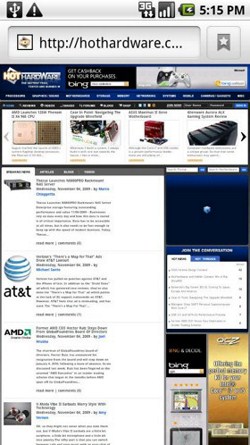Motorola DROID Does? A Deep Dive Look
Performance

The DROID's 3.7-inch display is crisp and pleasing to look at. The screen supports WVGA resolution at 480 x 854. The phone's accelerometer rotated the screen quickly whenever we rotated the handset. In terms of responsiveness, the DROID registered flicks and gestures without much, if any, lag. The DROID also offers haptic feedback to let you know when you've pressed an on-screen button.
Browsing the Web on the DROID is a pleasant experience, both due to the fact that the DROID has a large, high resolution screen as well as its Webkit HTML5 based browser.


We're seeing more and more phones follow Apple in offering multi-touch capabilities today. The DROID takes the opposite approach—it doesn't have multitouch. Although the phone may be technically capable of multitouch input, for whatever reason this functionality is not implemented on the DROID. Even without multitouch, the phone is very easy to use. For instance, a simple double-tap zooms in on a webpage, etc.
The phone's responsiveness however, no doubt is due in part to the processing engine under its hood.

ARM Cortext A8 Processor Block Diagram
Click to enlarge |
With smartphones, we spend a considerable amount of time talking about all of the phone's features, but it's important to remember that this is still a phone. As such, no review would be complete without addressing call quality. Overall call quality and sound during our tests was good, and we had no complaints. The earpiece was adequately loud and the phone's speaker also produced good quality sound. When testing the speakerphone, one person we spoke with complemented the overall clarity of the speaker and said they could hear us very well. To help avoid any accidental key presses while you're talking on the phone, the DROID has a proximity sensor that automatically turns on and off the display when you move it close to your ear and pull it away.
 We also can't go without mentioning the network that supports this phone. As you've heard before, Verizon offers 3G service throughout its coverage area, which also happens to blanket the majority of the continental U.S. Although service definitely varies from one region to the next, Verizon definitely has an impressive network to help support the DROID's full capabilities, especially since so many of the "killer" features on the phone take advantage of 3G speeds.
We also can't go without mentioning the network that supports this phone. As you've heard before, Verizon offers 3G service throughout its coverage area, which also happens to blanket the majority of the continental U.S. Although service definitely varies from one region to the next, Verizon definitely has an impressive network to help support the DROID's full capabilities, especially since so many of the "killer" features on the phone take advantage of 3G speeds. Searching for information that resides on the Web or on the phone is a breeze with the hardware search button as well as with the on-screen search controls. By tapping the search button on-screen or the hardware button, you'll enter search mode. To the right of many of the search screens, you'll see a small microphone icon. By tapping this icon, you'll activate voice search. During our tests, we were very impressed with the ease of use and accuracy of the DROID's voice search capabilities.
Another cool feature of the DROID is the new Google Maps Navigation Beta service. This pre-installed application provides free audible turn-by-turn directions with spoken street names, real time traffic information, and the ability to search nearby locations by voice. During our tests, the Google Maps Navigation Beta service worked very well and provided accurate and quick directions. When we took a wrong turn, the software quickly calculated a new route. The interface was pleasing to look at and provided helpful information much as you would find with a standalone GPS unit.
Motorola claims you should expect up to 6.4 hours of talk time on the DROID’s user replaceable battery. Overall, we were satisfied with the DROID’s battery life and were generally able to get a day’s worth of use from the phone while performing a variety of tasks including making calls, surfing the Web, etc. Of course, your experience may vary depending on how aggressively you use the phone’s capabilities.









